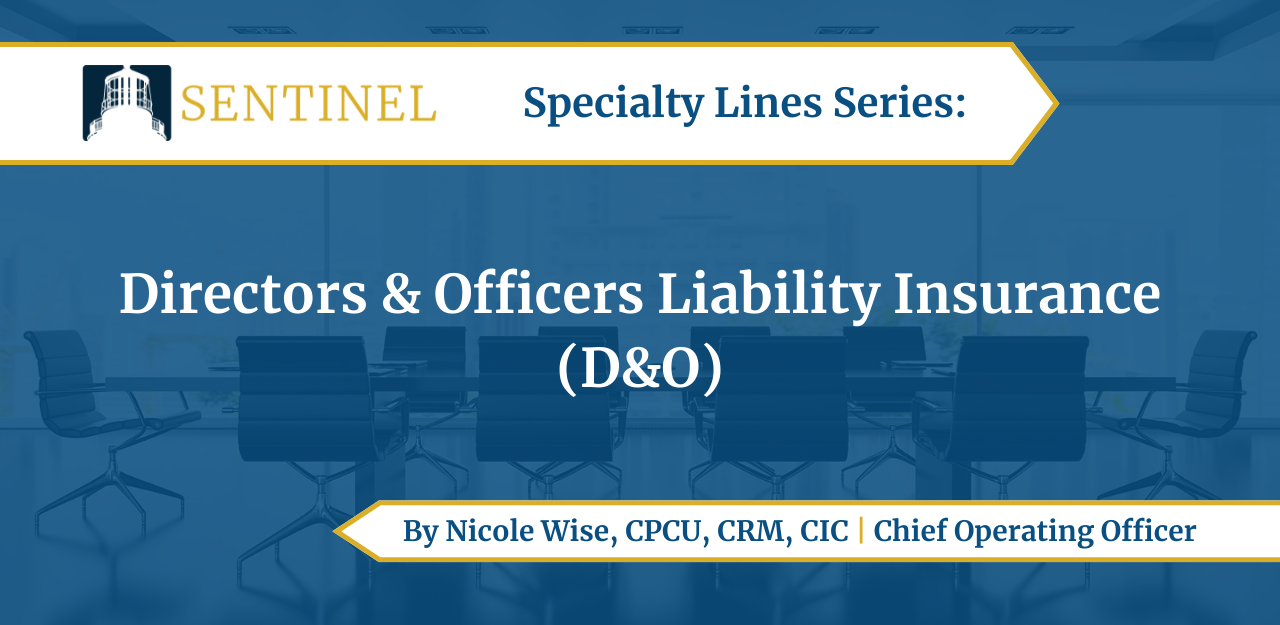Directors and Officers Liability Insurance (D&O) is available to cover directors and officers for claims made against them while serving on a board of directors and/or as an officer of a company. D&O can be written to cover the directors and officers of for-profit public businesses, privately held firms, not-for-profit organizations, and educational institutions.
D&O in effect is Management Errors and Omissions Insurance; covering claims from managerial decisions that have an adverse financial consequence. Directors owe a duty to care to the shareholders, customers, and employees. When they breach that duty of care, D&O can help cover the resulting damages. These policies contain “shrinking limits” provisions, meaning that defense costs (which are often a substantial part of a claim) reduce the policy limits. This approach contrasts with Commercial General Liability (CGL) policies, in which defense is covered in addition to policy limits.
Other distinctive features of D&O policies are that they: (1) are written on a claims-made basis, and (2) cover monetary damages but exclude bodily injury (BI) and property damage (PD) which is covered by General Liability. It is important to note that without D&O coverage the organization’s assets and the personal assets of board members are at risk in the event of an allegation. Policies not only cover the personal assets of the D&Os but their spouses as well.
How is Premium Determined?
The most common rating basis for premium for D&O is size, usually based on total revenues and total assets. Rates vary based on the length of time in business, financial health, scope and class of business, and prior claims history.
With respect to the company size, this can be determined by revenues or funding for not for profits. Newer companies are more concerning for underwriters as they don’t have proven history of effective management. Financial health, steady growth, and effective cash and debt management affects rates. A company with strong financials in an industry with positive economic outlook are treated more favorably.
Not-for-profit and for-profit accounts are written differently as are financial planners versus healthcare providers. What you do and how you do it affects premium. Lastly, any prior claim activity affects how an underwriter views and prices your account. Prior losses lead to higher rates.
The limit and retention chosen to have an effect on the overall premium once the underlying underwriting is determined. To assess your risk and offer options, specialty applications and financials must be submitted for review.
What Claims are Covered?
Claims arise from Wrongful Acts which may be a violation of statute, violation of articles of incorporation, transactions for personal gain just to name a few.
Often, claims arise from:
- Actual or Alleged Errors
- What if there was an allegation of violating laws relating to disposal of toxic waste. A D&O Policy may cover the cost of the investigation and penalties levied.
- Misleading Statements Made
- Think disclosing material facts, misleading information, or authorizing a false financial report.
- Breach of Duty
- What if an employee was embezzling money from a company and the shareholders sue for damages that rose since they failed to find the embezzlement and stop it.
- Improper Management
- Consider if a company sells a property valued at $1,000,000 for $500,000 to someone connected to an officer. A shareholder may sue for financial mismanagement.
- Failure to comply with workplace laws/lack of governance
Allegations can arise from:
- Vendors
- Competitors
- Current or Former Employees
- Shareholders
- Government Regulators
Exclusions
Like any insurance policy, coverage is given, and coverage is taken away through exclusions. It is important to understand the specific coverage forms as no two policies are written with the same coverage. Every carrier has their own filed policy forms; some broader, some more restrictive than others.
Common exclusions are BI/PD as already discussed since this is covered through General Liability, breach of contract, prior acts, and intentional and fraudulent acts. All coverages are not equal. Coverage and exclusions vary widely from carrier to carrier and even sometimes year to year with the same carrier.
Emerging Trends
2022 has been driven by Labor Shortages, Supply Chain Issues, Inflation, and continued social movements (Black Lives Matter and #MeToo). What these have led to are increased litigation, Tort Reform (attempts to reduce litigation), and legal decisions involving large jury rewards.
Adding to that, COVID-19; where senior leadership teams have continued to face scrutiny based on their pandemic responses, leading to allegations of mismanagement, increased litigation, and related D&O claims.
Three other emerging areas include:
- Cybersecurity struggles: Potential D&O losses can arise from allegations such as directors and officers failing to take reasonable steps to protect stakeholders’ personal or financial information, failing to implement controls to detect and prevent a cyberattack, and failing to report the incident or notify the appropriate parties in a timely manner.
- Environmental, social and governance (ESG) topics: there has been a steady increase in activists for ESG topics including:
- Climate Change and Pollution Actions
- Greenwashing: A deceptive marketing practice in which companies produce misleading information to trick consumers into believing an organization’s products, services or mission have more of a positive impact on the environment than is accurate.
- Executive pay: more companies are linking executive incentives to ESG-related metrics.
- Board diversity considerations: In 2021, the SEC approved a proposal from the NASDAQ that requires NASDAQ-listed organizations to either include or publicly share why they have chosen not to include a set number of diverse members on their senior leadership teams and disclose annual reports regarding their leadership teams’ self-identified characteristics.
D&O Statistics
A Chubb study showed that more than 25% of private companies reported a D&O loss over the span of three years, with 96% being negatively impacted financially. 2021 started a turning point in the world of D&O insurance. Competition is in full force and is keeping pricing in check. Single digit rate increases are common on average 5-8% which is significant improvement from prior years.
Now is the time to assess your Directors and Officers Liability risk and options. Consult with the professionals at Sentinel to Safeguard Your Success today.


